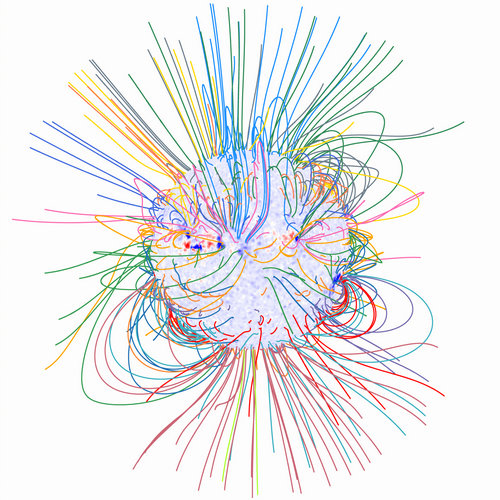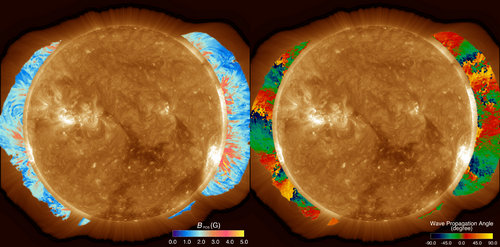The Sun is a magnetized star. The 11-year sunspot cycle and spectacular solar eruptions are both driven or governed by the evolution of the solar magnetic field.
The Sun’s magnetic field is essentially three dimensional and it occupies all layers of the solar atmosphere. However, routine measurements of the solar magnetic field have only been achieved at the photospheric level (solar surface). More than one century has passed since the first measurement of the solar magnetic field by a well-known astronomer George Ellery Hale, we still do not have a precise knowledge of the magnetic field in the outermost solar atmosphere, the corona. This limitation has impeded our complete understanding of the solar magnetism and many phenomena in the solar atmosphere.
An international team led by Prof. Hui Tian, who has a joint working contract at both Peking University and National Astronomical Observatories of Chinese Academy of Sciences (NAOC), has recently measured the global magnetic field of the solar corona for the first time. The team used observations from the Coronal Multi-channel Polarimeter (CoMP), an instrument operated by the High Altitude Observatory, National Center for Atmospheric Research, USA.
Two relevant papers were published in Science and Sci China Tech Sci, respectively, on August 6, 2020.
More than 20 years ago, a technique called coronal seismology or magneto-seismology has been introduced for coronal magnetic field measurements. This method makes use of some types of oscillations or waves that are observed in coronal structures. Based on the theory of plasma physics, the observed wave parameters can be used to infer the average magnetic field strengths in the oscillating structures. It is similar to the technique of inferring the properties of the Earth from waves observed during earthquakes. However, these oscillations/waves are just occasionally observed in small regions of the corona, and thus their potential for magnetic field measurements is limited.
CoMP is a coronagraph with a 20-cm aperture. It can observe the solar corona using the Fe XIII 1074.7 nm and 1079.8 nm infrared spectral lines. The Doppler image sequence obtained from CoMP observations often reveal the prevalence of propagating periodic disturbances, indicating the ubiquitous presence of transverse plasma waves in the corona. The team has successfully applied the magneto-seismology method to these pervasive waves. They have extended the previously developed wave-tracking technique to the whole field of view, and obtained the distribution of the wave propagation speed in the global corona. They also obtained a global map of the coronal density from observations of the two Fe XIII lines. Combing the maps of wave propagation speed and density, they have successfully mapped the magnetic field in the global corona.
This is the first measurement of the global coronal magnetic field. In principle, by applying this technique to CoMP-like instruments in the future, global coronal magnetic field maps could be routinely obtained, filling in the missing part of the measurements of the Sun’s global magnetism. Such measurements could provide critical information to advance our understanding of the physical mechanisms responsible for solar eruptions and the 11-year sunspot cycle.

Fig.1 Magnetic field of the Sun calculated from a theoretical model (Credit: Zihao Yang & Hui Tian).

Fig.2 A map of the coronal magnetic field strength (left) and direction (right) superimposed on a coronal image taken by the AIA instrument on the Solar Dynamics Observatory (Credit: Zihao Yang & Hui Tian).
The two papers can be accessed, respectively, at the following links:
1. https://science.sciencemag.org/content/369/6504/694
2. http://engine.scichina.com/doi/10.1007/s11431-020-1706-9

Address: 20A Datun Road, Chaoyang District, Beijing, China code: 100012
Tel: 010-64888708 E-mail: naoc@nao.cas.cn

